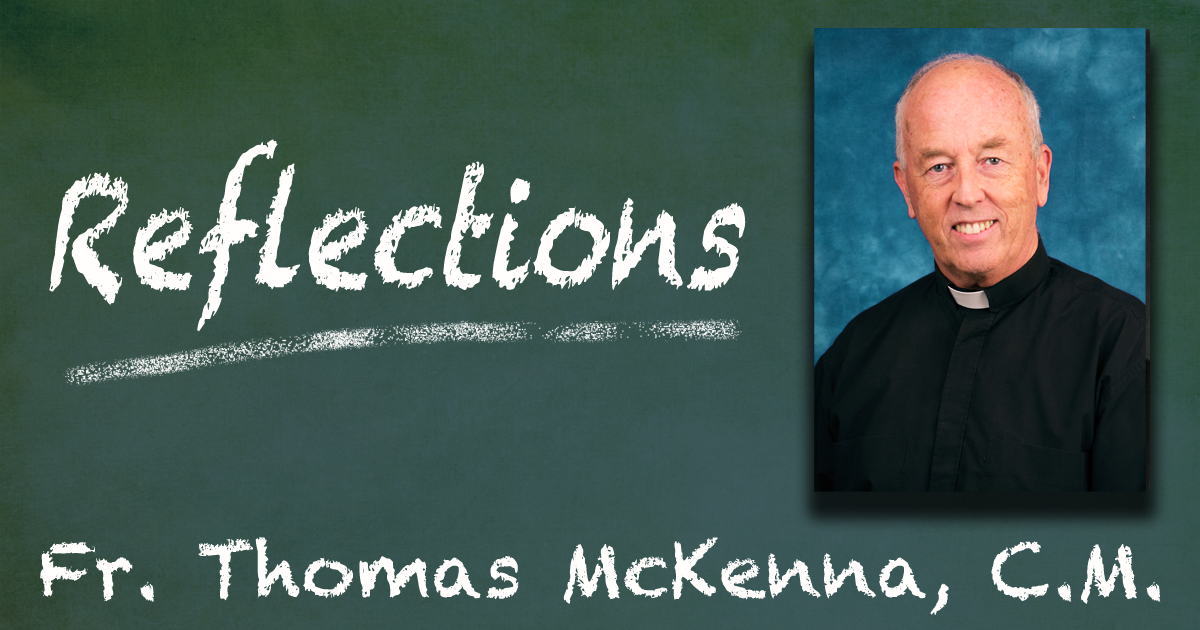
Emmaus and The Eucharist (Lk 24:13-35)
Many people’s favorite story in the New Testament is the one of the two disciples on the road to Emmaus. It contains so much of everyone’s experience of what it is to believe — and certainly touches on the belief of a Vincentian. Life on the road, doubt and discouragement, welcoming in the stranger, eating an everyday meal, and the recognition of the specialness of people sitting with us right there at table.
One of the surprising things is how often this story from Luke enters into considerations of the Eucharist. And just as surprising is the fact that it is not so much the phrase “the breaking of the bread” that gets the attention, but more the whole incident.
Different writers point out that this story, in its sequence of events, is the most reliable and solid framework for grasping what went on at the earliest Eucharistic celebrations. Our own appreciation of the Eucharist now can be deepened by noticing the mood, tone and content of this event.
The movement in the plot-line is clear enough.
- It begins with neediness, two people in a confused, discouraged, even blown-apart state of mind, searching for help, and in the market for healing and hope. They are open.
- Then comes enlightenment by the Word of God from this stranger’s way of putting together the pieces of Scripture that opens vistas and makes connections which they experience as freeing and soul-expanding. It is saving.
- Then their gratitude for that, triggering off a generous, other-directed response, and that is hospitality — or better, the desire for closer union and communion. “Come and join us and enter into our circle. Sit down here at this meal and let’s share not just this food but even each other.” They are grateful.
- Then when the bread is broken and shared, there’s the recognition of Who’s involved in the sharing — not just them, but Jesus The Risen Lord, right there in their midst. They are awed.
- Finally, their gratitude for that togetherness and intimacy translates into the impulse to spread the wonder and goodness of what happened to them to others. They go out on a mission.
In this nutshell, we see the things which sharing in any Eucharist aims to bring about: openness, enlightenment, invitation and hospitality, bread-sharing triggering recognition of who is really there, and finally heading out to the world to proclaim what just happened. And all of this happening in and through a community assembled for the meal of the Risen Lord.
It’s easy to see why writers hold up this story as a Eucharistic window. They recognize in it the basic elements and fundamental emphases for any Sunday celebration. And by the same token, they use it as a measure for judging periods and movements in which things got out of focus.
For instance, there were times when the Eucharist was presented primarily as something to be watched, something before which people come more as spectators than involved participants. And thus, eras when the emphasis was put on “the miracle” going on there up there on the altar, the moment of consecration. Here the main thing the congregation was to do was marvel at the event, bow in reverence at the wonder of this supernatural transformation. For sure there’s truth here, but following Emmaus it’s clear that’s not the whole truth. There’s a miracle alright, but the story shows how that wondrous change is happening just as much inside the hearts of the two people gathered there, in their transformation, in their eyes opening up to what the Scriptures mean and in the birth of their new hope and sense of mission.
In other words, the Eucharist is not something to be watched so much as to be entered into and to get involved in in order that like the Emmaus disciples we can be swept into its meaning and power. It’s meant to take us ever deeper into the communion it brings about and wants to strengthen. The action is not only “up there” on the altar but “all around the altar,” occurring inside all those assembling there in Jesus’ name — and being changed in the process. The transformation going on is not only inside the bread but indeed inside the two enraptured disciples.
So the pattern this Emmaus story lays out is a blue print for entering into any celebration of the Eucharist. It elicits:
- a sense of our neediness as we come to the celebration. (“Lord have mercy.”)
- a willingness to be moved by the Scriptures. (Listening attentively to the readings.)
- a hospitality to the Lord and to one another. (Offering our gifts and our very own selves.)
- a breaking and sharing the gifts (Doing this not only with the Lord Jesus, but with each other and the wider world)
- a deep gratitude for all this enlightenment, hospitality, and love for the other that spills over into mission to the world. (Being sent out to proclaim the Good News of God’s love in both word and action.)
Walking along the road to Emmaus. It’s a scene loaded with appreciations for how to enter more fully into the Eucharist. And isn’t this especially the case for Vincentians who are gathered by The Lord and then sent out to bring the Bread and Wine of God’s love to the outcasts of the world.





0 Comments